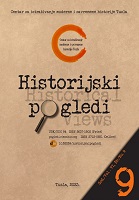FROM PROPAGANDA TO PUBLIC DIPLOMACY: DID EXCHANGE PROGRAMS BRING DOWN THE COLD WAR?
FROM PROPAGANDA TO PUBLIC DIPLOMACY: DID EXCHANGE PROGRAMS BRING DOWN THE COLD WAR?
Author(s): Labinot HajdariSubject(s): Public Administration, Diplomatic history, Political history, Social history, Political behavior, Politics and society, History of Education, Post-War period (1950 - 1989), Cold-War History
Published by: Centar za istraživanje moderne i savremene historije Tuzla
Keywords: Cold War; Propaganda; Public Diplomacy; Education Programs; Cultural programs;
Summary/Abstract: During the Cold War public diplomacy was far more advanced, dynamic, and all-inclusive than we give credit. The Cold War shaped domestic and foreign policies for many decades, worldwide. With the United States and the Soviet Union as the main protagonists of the bipolar world, using international broadcasting shaped the attitudes of the countries in a favorable stance for the two superpowers, to comply with the competing ideologies. This article investigates the role of public diplomacy through media, education, and cultural programs, and the role they played in bringing down the Cold War. Educational and Cultural programs played an especially influential role in the superpower’s strategies and competing agendas on who wins more hearts and minds. Through the use of historical research methods, combined with discourse and content analysis of books, archived official documents, podcasts, newspapers, and publications, draw a pattern of empowerment and transformation of such tools as propaganda into public diplomacy, which in the beginning deepened the distance between East and West, while later was used to win hearts and minds. As this article analyzes, public diplomacy played an important role during the Cold War, emerging in the initial years of the war itself. Through a sophisticated strategy of using common bridges among people as a connection such as science, music, sports, and education exchange programs, considered at that time to be entirely divided from the political sphere, the United States as the leading Western democracy managed to get into the hearts and minds of the Soviet people. Among the most popular models of using public diplomacy was that of a hostile nature of relationships, intending to achieve results in foreign publics. The hypothesis was that if the images persuaded the targeted foreign public of the other side, they would pressure their governments to change their hostile positions and politicize toward the other side. Public diplomacy was that counterbalance to nuclear power competition, which was dominated by campaigns that aimed to gain influence and win the support of the international global society, and it inspired different countries, to use different tools to achieve their international goals. Programs such as the Fulbright, International Visitors Program, and "People to People” program, founded with the purpose to promote the United States' goodwill through educational exchange programs in the field of culture and science, philanthropy, and humanitarian activities, changed the perspective of communication and understanding between the United States and other nations, but also as an important step toward world peace. In the meantime, this strategy eroded the foundations of Soviet ideology and was considered by Soviet diplomats as a Trojan horse that caused the fall of its entire system. This article also investigates how propaganda transformed into public diplomacy and became institutionalized and recognized as a powerful tool through which states can maintain relations with one another in the spirit of cooperation. The analysis concludes that public diplomacy was one of the main factors that melted the iron division between the U.S and the USSR, yet brought down the Soviet Union itself
Journal: HISTORIJSKI POGLEDI
- Issue Year: VI/2023
- Issue No: 9
- Page Range: 225-241
- Page Count: 17
- Language: English

